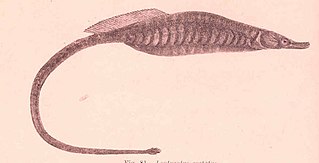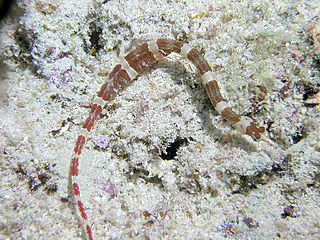
The Syngnathidae is a family of fish which includes seahorses, pipefishes, and seadragons. The name is derived from Ancient Greek: σύν, meaning "together", and γνάθος, meaning "jaw". The fused jaw is one of the traits that the entire family have in common.
The chain pipefish is a pipefish species. It inhabits the western Atlantic from Virginia, Bermuda and northern Gulf of Mexico to Campeche and Jamaica, but is absent from the Bahamas. It is a marine subtropical reef-associated fish, up to 38 cm length.

The robust ghost pipefish, also known as the blue-finned ghost pipefish, Racek's ghost pipefish, robust-snouted ghost pipefish, or the squaretail ghost-pipefish, is a species of false pipefish belonging to the family Solenostomidae. Its appearance can vary greatly due to its ability to change colors over several hours, but the general body shape and fin shapes allow it to mimic a piece of seagrass.

The deepbody pipefish is a species of pipefish endemic to Australia where it is only found along the southern coast. This species grows to a length of 12.9 centimetres (5.1 in) SL. This species is the only known member of the monotypic genus Kaupus which is named in honour of the ichthyologist Johann Jakob Kaup (1803-1873).

The Halimeda ghost pipefish, Solenostomus halimeda, is a species of false pipefishes belonging to the family Solenostomidae.

Corythoichthys amplexus, known commonly as the brown-banded pipefish, is a species of marine fish in the family Syngnathidae.
Hippichthys cyanospilos, commonly known as the blue spotted pipefish or bluespeckled pipefish, is a marine fish belonging to the family Syngnathidae, native from the Indo-Pacific area.

Choeroichthys brachysoma is a species of marine fish of the family Syngnathidae.
Choeroichthys cinctus is a species of marine fish of the family Syngnathidae. It is found in the Western Pacific Ocean, from Indonesia and the Philippines to Samoa, where it usually inhabits sheltered reef habitats at depths over 10 metres (33 ft). It can grow to lengths of 10 centimetres (3.9 in). This species is ovoviviparous, with males carrying eggs in a brood pouch until giving birth to live young. Males may brood at 3 centimetres (1.2 in).
Choeroichthys sculptus, the sculptured pipefish, is a species of marine fish of the family Syngnathidae.
Choeroichthys smithi is a species of marine fish of the family Syngnathidae. It is found in the western Indian Ocean along the coasts of Reunion, Mauritius, the Seychelles, Madagascar, Tanzania, Mozambique, and South Africa. It is a demersal species, inhabiting tide pools and reef flats in coastal waters where it can grow to lengths of 5 cm. This species is ovoviviparous, with males carrying the eggs and giving birth to live young. The specific name honours the South African ichthyologist J.L.B. Smith (1897-1968) who collected the material which was used as the holotype by Dawson when he described the species.

Doryrhamphus negrosensis, commonly known as Negros pipefish, flagtail pipefish, Masthead Island pipefish or Queensland flagtail pipefish, is a species of marine fish of the family Syngnathidae. It is found in the Western Pacific Ocean, from Borneo to Vanuatu and the Yaeyama Islands to the Rowley Shoals and the Great Barrier Reef. It lives in mud flats and reefs, both coral and rocky, where it is often associated with sea urchins. It is a rather solitary species which may be found in pairs or small groups. It inhabits depths to 9 metres (30 ft), and can grow to lengths of 6.2 centimetres (2.4 in). Although little is known of its feeding habits, it is expected to feed on harpacticoid copepods, gammarid shrimps, and mysids, similar to other pipefish, it may also act as a cleaner fish like other species in the genus Doryrhamphus. This species is ovoviviparous, with males carrying eggs before giving birth to live young. Males may brood at 4.3 cm. It is a small bluish to bluish-grey pipefish which has a pale stripe along the dorsal side of the head and snout, and a dark fan-like caudal fin which has white margins and an orange base.
Gibbs’ pipefish is a species of marine fish of the family Syngnathidae. It is found in the Western Pacific, from the Great Barrier Reef to Palau, the Chesterfield Islands and New Caledonia. Unconfirmed specimens have been reported off of the Seychelles in the Indian Ocean. It lives in coastal sandy or rubble habitats, as well as areas with sponges and coralline algae, where it can grow to lengths of 8 centimetres (3.1 in). It is expected to feed on small crustaceans, similar to other pipefish. This species is ovoviviparous, with males brooding eggs and giving birth to live young. Males may brood at lengths of around 5 centimetres (2.0 in). The specific name honours P. E. Gibbs, who collected the type material.
Gray's pipefish, also known as the mud pipefish or spiny pipefish is a species of marine fish of the family Syngnathidae. It is found in the Indo-Pacific in the Gulf of Aden, Sri Lanka, and from the Gulf of Thailand to Japan, the Marshall Islands, and the Great Barrier Reef. It lives to depth of 100 metres (330 ft), and planktonic juveniles have been found above depths of 3,000 metres (1.9 mi). It occurs in muddy habitats, in estuaries, and on coral reefs, where it likely feeds on small crustaceans. It can grow to lengths of 20 centimetres (7.9 in). This species is ovoviviparous, with males carrying eggs in a brood pouch before giving birth to live young.

The Samoan pipefish, or brown pipefish, is a species of marine fish of the family Syngnathidae. It is found in the Indo-Pacific, from the Red Sea, to Sodwana Bay, to Taiwan, the Marshall Islands, and Samoa, where it inhabits tidepools and coral and rocky reefs to depths of 15 metres (49 ft). It is a solitary species with cryptic habits and is rarely observed. It is likely to feed on small crustaceans, and can grow to lengths of 14 centimetres (5.5 in). This species is ovoviviparous, with males carrying the fertilised eggs in a brood pouch, the folds of which fall well short of the centre of the egg-filled pouch, eventually giving birth to live young.
Phoxocampus tetrophthalmus, the trunk-barred pipefish, is a species of marine fish belonging to the family Syngnathidae. This species can be found in reefs and tide pools of the Indo-Pacific specifically Indonesia, the Philippines, and Guam. They have also been observed in the Andaman, Cocos-Keeling, and Ryukyu islands. Their diet likely consists of small crustaceans Reproduction occurs through ovoviviparity in which the males brood eggs before giving live birth.
Nannocampus pictus, also known as the reef pipefish, is a species of marine fish belonging to the family Syngnathidae. They can be found inhabiting reefs and seagrass beds of the western Indian Ocean and the eastern coast of Australia including the Great Barrier Reef. Members of this species can grow to lengths of 10 cm and their diet likely consists of small crustaceans such as copepods. Reproduction occurs through ovoviviparity in which the males brood eggs before giving live birth.
Nannocampus subosseus, also known as the bony-headed pipefish, is a species of marine fish belonging to the family Syngnathidae. They can be found inhabiting reefs and tide pools only in the region of Shark Bay to Esperance, Western Australia. Members of this species can grow to lengths of 12 cm and their diet likely consists of small crustaceans such as copepods. Reproduction occurs through ovoviviparity in which the males brood eggs before giving live birth.
Nannocampus weberi, also known as the reef-flat pipefish, is a species of marine fish belonging to the family Syngnathidae. They can be found inhabiting reefs in the Lesser Sunda Islands of Indonesia particularly the islands of Sumba and Bali. Their diet likely consists of small crustaceans such as copepods. Reproduction occurs through ovoviviparity in which the males brood eggs before giving live birth.

Vanacampus phillipi, also known as the Port Phillip pipefish, is a species of marine fish belonging to the family Syngnathidae. They can be found inhabiting seaweed and seagrass beds along the southern coast of Australia from Perth to Jervis Bay, New South Wales including the coast of Tasmania. Their diet consists of small crustaceans such as copepods, amphipods, and mysid shrimps. Reproduction occurs through ovoviviparity in which the males brood eggs before giving live birth to 50 or less offspring.









